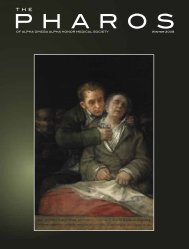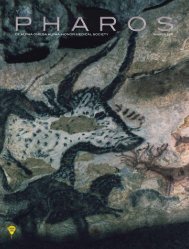4 - Alpha Omega Alpha
4 - Alpha Omega Alpha
4 - Alpha Omega Alpha
Create successful ePaper yourself
Turn your PDF publications into a flip-book with our unique Google optimized e-Paper software.
cording to the authors is that the color,<br />
texture, and smell of a cadaver is not<br />
like real life and cadavers cannot be<br />
auscultated, palpated, or usefully asked<br />
to change position. 2<br />
I am a medical educator and the<br />
medicine program coordinator in my<br />
medical school, and am interested in<br />
strategies to deal with the knowledge<br />
explosion in medicine. These days<br />
knowing “what not to teach” according<br />
to me is as important as knowing what<br />
to teach. A possible problem is that<br />
anatomists and anatomy teaching have<br />
concentrated on the requirements of<br />
surgeons and surgical specialties. The<br />
majority of medical graduates will not<br />
be surgeons and the anatomical knowledge<br />
they need and the way they approach<br />
the body may be quite different.<br />
During my undergraduate days I<br />
was taught the detailed relations of<br />
various nerves and blood vessels. I do<br />
not remember any of that now and<br />
also did not find it useful in practice.<br />
I personally feel that the procedures<br />
like peer examination, body projection,<br />
and other methods adopted in the U.K.<br />
school 2 will equip students with a more<br />
relevant knowledge of anatomy. A doctor<br />
while doing a physical examination<br />
(palpation) should be able to visualize<br />
what structures lie underneath the<br />
examining hand and should also know<br />
about the surface anatomy of different<br />
organs. With the widespread availability<br />
of CT scans and MRIs cross-sectional<br />
anatomy is becoming more important.<br />
In my undergraduate days, anatomy<br />
was taught in a traditional manner and<br />
was not clinically oriented. Dissection<br />
may be useful in that it is a group activity<br />
and learning takes place in consonance<br />
with adult learning principles.<br />
Students can also be introduced to<br />
death in a sensitive manner. However,<br />
this objective was not fulfilled during<br />
my undergraduate days. Most medical<br />
schools in South Asia do dissections<br />
as a mechanical activity which is mandatory<br />
as it has been included in the<br />
curriculum. I feel medical educators<br />
and doctors other than anatomists and<br />
surgeons should also be engaged in the<br />
important issue of curriculum design.<br />
This may also be required for other<br />
basic science subjects. Their broader<br />
and more holistic viewpoint can have<br />
a significant impact on the narrower<br />
viewpoint of subject experts resulting<br />
in a more relevant curriculum.<br />
Anatomy describes the setting of<br />
events, as rightly pointed out by the<br />
author. The questions are what methods<br />
to use to teach and learn about the<br />
body and to what depth to teach and<br />
which details are necessary and which<br />
are irrelevant and may be omitted.<br />
The guiding principle I feel is that the<br />
undergraduate course in most parts of<br />
the world prepares the student for a<br />
career as a primary care physician. The<br />
teaching of all subjects should keep<br />
in mind this important fact. Facts and<br />
details needed for various postgraduate<br />
courses can be better taught during the<br />
particular course and not during the<br />
undergraduate days!<br />
References<br />
1. Vijayabhaskar P, Shankar PR, Dubey<br />
AK. Emotional impact of cadaver dissection:<br />
a survey in a medical college in western<br />
Nepal. Kathmandu Univ Med J 2005;<br />
3: 143–48.<br />
2. McLachlan JC, De Bere SR. How we<br />
teach anatomy without cadavers. The Clinical<br />
Teacher 2004; 1: 49–52.<br />
Dr. P. Ravi Shankar<br />
Department of Medical Education<br />
KIST Medical College<br />
Lalitpur, Nepal<br />
AΩA membership—more than<br />
high GPA<br />
In recent years, the Gamma AΩA<br />
chapter at UT Southwestern had been<br />
making student nominations based<br />
strictly on GPA, and individuals were<br />
only nominated during their senior<br />
year of medical school. Last year, the<br />
chapter leadership made two important<br />
changes in its selection process.<br />
First, selection criteria were changed<br />
to incorporate leadership, research,<br />
and service activities as outlined in the<br />
AΩA Constitution. Second, for the first<br />
time in over a decade, members were<br />
nominated from the junior class.<br />
The benefits of making these two<br />
minor changes in the selection process<br />
have been tremendous. Weighing<br />
leadership, research, and community<br />
service in the selection process better<br />
insures that student members have the<br />
skill set and commitment necessary<br />
to foster a dynamic organization. By<br />
selecting a small group of members<br />
and student officers prior to the fourth<br />
year, the organization’s leadership has<br />
had more time to identify and organize<br />
projects that serve the community and<br />
that boost the visibility of the organization<br />
and its ideals on campus.<br />
After their selection last spring, the<br />
student officers met with the chapter<br />
councilor, executive committee, and<br />
outgoing student officers. Following<br />
this meeting, the new officers together<br />
came up with ideas for several new<br />
programs designed to improve the<br />
university community, serve the community<br />
at large, and strengthen the ties<br />
of its faculty and former student members.<br />
The officers then organized a<br />
meeting with the newly-selected junior<br />
AΩA members to discuss these project<br />
ideas, identify those ideas with the<br />
most member support, and delegate<br />
responsibilities for development and<br />
implementation.<br />
The AΩA student leadership and<br />
members identified several opportunities<br />
to provide service to the university<br />
community. The organization made<br />
one of its goals to encourage a collegial<br />
atmosphere among medical students.<br />
To achieve this goal, AΩA worked with<br />
the university administration to create<br />
a program where each of the forty<br />
AΩA members serves as a mentor to<br />
the small groups of first- and secondyear<br />
students within the newly created<br />
UTSW Colleges. These mentors<br />
provide support by assisting with instruction<br />
in performing different components<br />
of the physical exam, working<br />
with students to improve their patient<br />
The Pharos/Spring 2009 51














